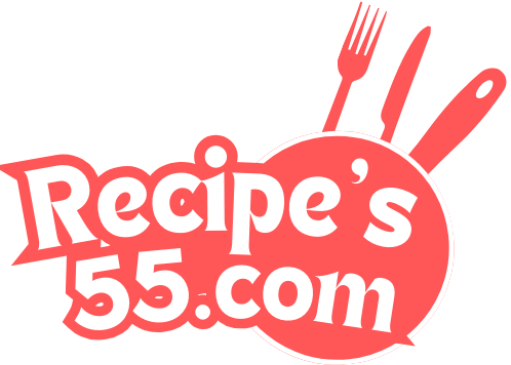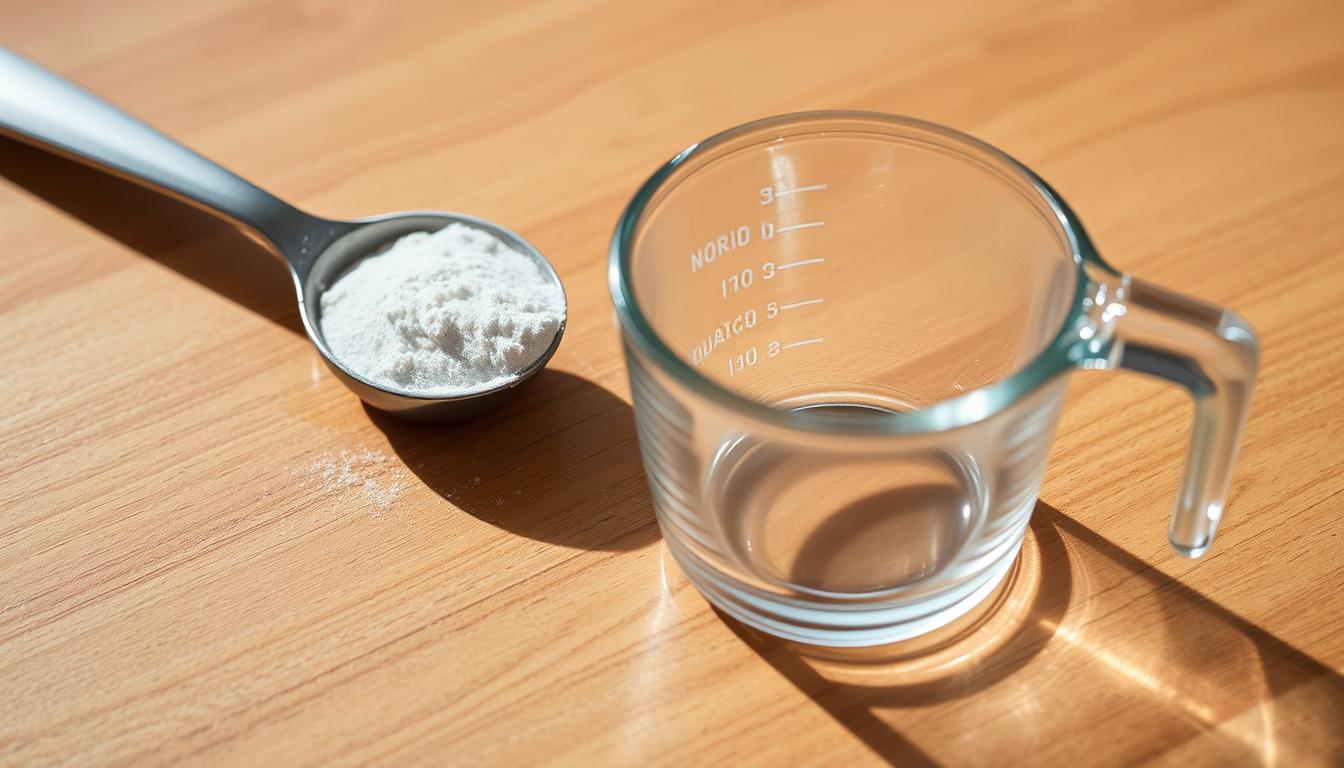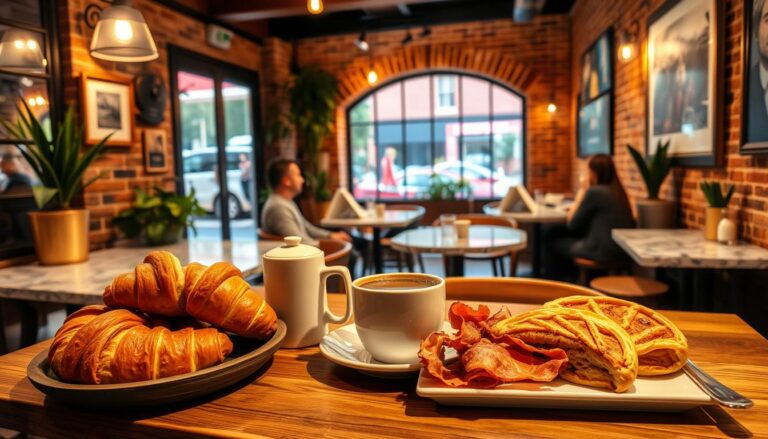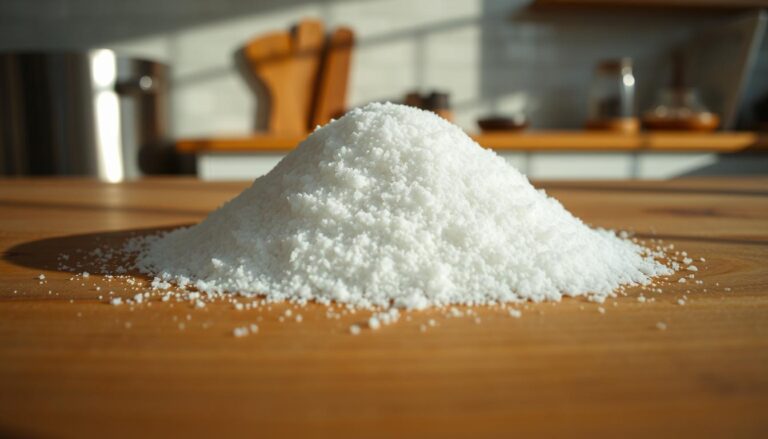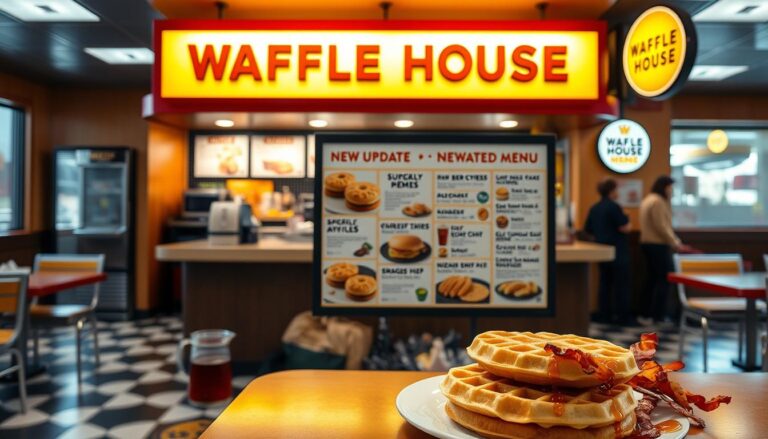Tablespoon to 1/4 Cup Conversion Explained
Mastering kitchen measurement basics is crucial for achieving success in cooking and baking. One fundamental conversion to understand is the relationship between tablespoons and cups. Whether you’re scaling up a recipe or adjusting ingredient quantities, being able to convert between these units is essential.
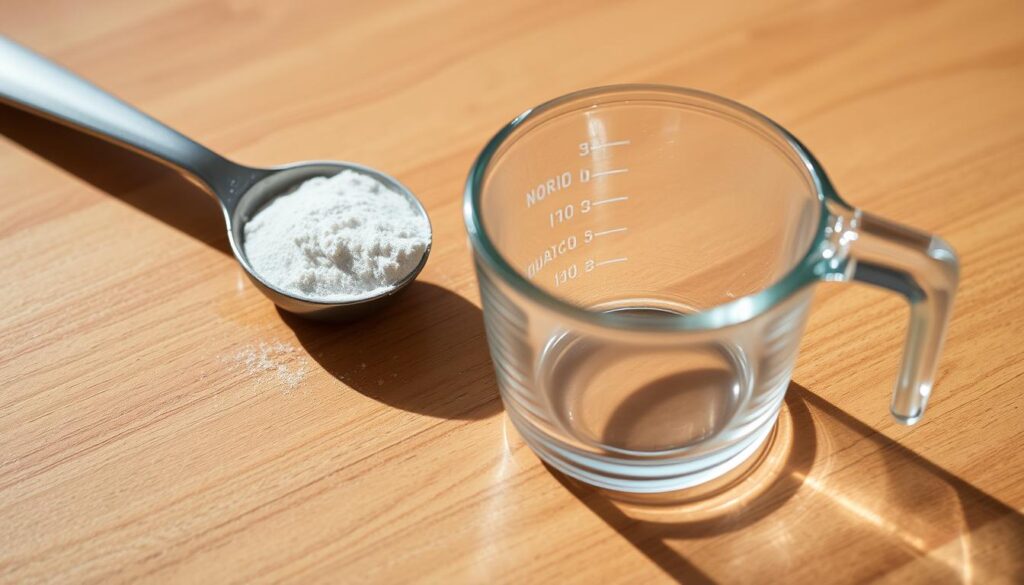
In many recipes, ingredients are listed in cups, but you may need to convert these measurements to tablespoons or vice versa. Understanding this conversion is particularly important when working with ingredients that require precise measurement, such as spices or leavening agents.
Key Takeaways
- Understanding the tablespoon to cup conversion is vital for accurate recipe execution.
- Kitchen measurement basics are essential for achieving consistent results in cooking and baking.
- Converting between tablespoons and cups is a fundamental skill for any home cook or baker.
Understanding Kitchen Measurements Basics
Accurate kitchen measurements are the backbone of successful cooking and baking. In the US, cooking measurements are typically based on the US customary system, which includes units such as cups, tablespoons, and teaspoons.
The Importance of Accurate Measurements in Cooking
Measurement accuracy is crucial in cooking, as it directly affects the final product. Inaccurate measurements can lead to disappointing results, such as an overly salty dish or a cake that’s too dense. To achieve the desired outcome, it’s essential to use precise measurements when following a recipe.
In cooking, measurements can impact the texture, flavor, and overall quality of a dish. For instance, too much liquid can make a sauce too thin, while too little can make it too thick. Similarly, incorrect measurements of ingredients like spices and seasonings can alter the flavor profile of a dish.
Common Kitchen Measurement Units in the US
The US customary system uses various units to measure ingredients, including cups, tablespoons, and teaspoons. Cups are often used to measure dry ingredients like flour and sugar, while tablespoons and teaspoons are used for smaller measurements, such as spices and oils.
Understanding these units and how to convert between them is essential for achieving accurate measurements. For example, knowing that 1 cup is equal to 16 tablespoons can help you scale up or down a recipe.
How Measurements Affect Recipe Outcomes
The outcome of a recipe is directly related to the measurements used. In baking, for instance, measurements must be precise to ensure the right chemical reactions occur, resulting in a cake that’s light and fluffy. In cooking, measurements can impact the balance of flavors and textures, making a dish more or less enjoyable.
A simple table can help illustrate the impact of measurements on recipe outcomes:
| Measurement | Effect on Recipe |
|---|---|
| Inaccurate measurements | Disappointing results, such as an overly salty dish or a dense cake |
| Accurate measurements | Desired outcome, with balanced flavors and textures |
How Many Tablespoons in 1/4 Cup: The Simple Answer
Mastering kitchen conversions, such as tablespoons to cups, is a valuable skill for any home cook or baker. One of the most common conversions needed in the kitchen is understanding how many tablespoons are in 1/4 cup.
The Standard Conversion Formula
In the US customary system, 1 cup is equal to 16 tablespoons. To find out how many tablespoons are in 1/4 cup, we can use a simple conversion formula: 1 cup = 16 tablespoons, so 1/4 cup = 16 * 0.25 = 4 tablespoons. Therefore, there are 4 tablespoons in 1/4 cup. This conversion is straightforward and applies to both liquid and dry ingredients.
Visual Representation of the Conversion
To better understand this conversion, it can be helpful to visualize it. Imagine a standard 1-cup measuring cup. Filling this cup to 1/4 full would be equivalent to 4 tablespoons. This visual representation can aid in quickly converting between these units in your mind, making cooking and baking more intuitive.
Why This Conversion Is Frequently Needed
The conversion from 1/4 cup to tablespoons is frequently needed in various recipes, especially in baking and making sauces or marinades. Many recipes, particularly those for baked goods, desserts, or specific sauces, often require measurements in cups, but when you’re working with ingredients in smaller quantities, having the ability to convert these measurements to tablespoons is invaluable. This conversion is also useful when you’re missing a measuring cup but have a tablespoon measure available.
By understanding and applying this simple conversion, home cooks and bakers can ensure their recipes turn out as intended, with the right balance of ingredients. Whether you’re following a recipe or experimenting with your own creations, knowing that 1/4 cup equals 4 tablespoons can make a significant difference in the outcome of your dishes.
The Science Behind Measurement Standards
Behind every recipe lies a story of measurement standards, which have evolved over time to become the US customary measurements used today. The history of measurement standards is a fascinating tale of how different cultures and civilizations have contributed to the development of the systems we use in cooking today.
How US Customary Measurements Were Established
The US customary measurements have their roots in the British Imperial System, which was adopted from the British Empire. Over time, the United States made slight modifications to create its own system. The US customary measurements are based on the definitions of the fundamental units such as the tablespoon and cup.
The Relationship Between Tablespoons and Cups
The relationship between tablespoons and cups is a fundamental aspect of cooking. In the US customary system, 1 cup is equal to 16 tablespoons. This conversion is crucial for accurately measuring ingredients in recipes. Understanding this relationship is essential for cooks to achieve the desired results in their cooking and baking.
Why Standardization Matters in Cooking
Standardization in cooking is vital for ensuring consistency and accuracy in recipe outcomes. Without standardized measurements, recipes can be ambiguous, leading to varying results. The use of standardized measurements such as the tablespoon and cup helps to eliminate this ambiguity, making it easier for cooks to achieve the desired results.
Standardization is key to achieving consistency in cooking. By using standardized measurements, cooks can ensure that their dishes turn out as expected, every time.
Common Cooking Scenarios Requiring 1/4 Cup Measurements
From cookies to cocktails, 1/4 cup is a versatile measurement that appears in many recipes. This measurement is crucial in various cooking scenarios, including baking, cooking, and making beverages.
Baking Applications: From Cookies to Cakes
In baking, 1/4 cup is a common measurement for ingredients like sugar, flour, and chocolate chips. For example, a classic chocolate chip cookie recipe might call for 1/4 cup of granulated sugar, while a decadent chocolate cake recipe might require 1/4 cup of unsweetened cocoa powder.
When baking, it’s essential to use the correct measuring technique to ensure the best results. This includes using dry measuring cups for dry ingredients and leveling off the ingredients to avoid over- or under-measuring.
Cooking Applications: Sauces and Marinades
In cooking, 1/4 cup is often used to measure ingredients for sauces and marinades. For instance, a simple pasta sauce recipe might call for 1/4 cup of olive oil, while a marinade for grilled chicken might require 1/4 cup of soy sauce.
Using the correct measurement is crucial in cooking, as it can affect the flavor and texture of the final dish. In sauces and marinades, 1/4 cup can be a critical measurement that makes a big difference in the overall outcome.
Beverage Recipes: Cocktails and Smoothies
1/4 cup is also a common measurement in beverage recipes, such as cocktails and smoothies. For example, a classic cocktail recipe might call for 1/4 cup of simple syrup, while a refreshing smoothie recipe might require 1/4 cup of yogurt or milk.
When making beverages, accurate measurements are essential to achieve the desired flavor and texture. Using 1/4 cup measurements can help ensure that your cocktails and smoothies turn out just right.
| Recipe | 1/4 Cup Measurement | Ingredient |
|---|---|---|
| Chocolate Chip Cookies | 1/4 cup | Granulated Sugar |
| Pasta Sauce | 1/4 cup | Olive Oil |
| Cocktail | 1/4 cup | Simple Syrup |
Converting Between Tablespoons and 1/4 Cup for Different Ingredients
Different ingredients require different approaches when converting between tablespoons and 1/4 cup. This conversion is crucial in cooking, as it directly affects the outcome of a recipe. Understanding how to accurately convert between these units is essential for achieving the desired flavor, texture, and consistency in various dishes.
Liquid Ingredients: Water, Oils, and Extracts
Liquid ingredients, such as water, oils, and extracts, have a relatively straightforward conversion between tablespoons and 1/4 cup. Since 1 cup is equal to 16 tablespoons, 1/4 cup is equivalent to 4 tablespoons. This conversion applies to most liquid ingredients, making it easy to scale recipes up or down. For instance, if a recipe calls for 1/4 cup of olive oil, you can simply use 4 tablespoons instead.
Dry Ingredients: Flour, Sugar, and Spices
Dry ingredients, such as flour, sugar, and spices, require a slightly different approach when converting between tablespoons and 1/4 cup. The density of these ingredients can vary, affecting the accuracy of the conversion. For example, 1/4 cup of all-purpose flour may not weigh the same as 1/4 cup of granulated sugar. To ensure accuracy, it’s best to use a digital kitchen scale or measuring cups specifically designed for dry ingredients.
Semi-Solid Ingredients: Butter, Yogurt, and Honey
Semi-solid ingredients, like butter, yogurt, and honey, can be challenging to convert between tablespoons and 1/4 cup due to their unique textures and densities. For instance, honey is denser than butter, so the same volume measurement will result in different weights. When working with semi-solid ingredients, it’s essential to consider their specific characteristics to achieve accurate measurements.
Special Considerations for Sticky Substances
Sticky substances, such as honey and syrup, require special care when measuring. To avoid spills and ensure accurate measurements, it’s best to use a measuring spoon or cup with a smooth, non-stick surface. Additionally, measuring sticky substances at room temperature can help prevent errors.
Kitchen Tools for Accurate Measurement
To achieve precise measurements, it’s essential to have the right kitchen tools at your disposal. Accurate measurements are the backbone of successful cooking and baking, and the right tools can make all the difference.
Types of Measuring Spoons and Their Uses
Measuring spoons are a fundamental kitchen tool, used to measure ingredients such as spices, extracts, and seasonings. They come in various sizes, from teaspoons to tablespoons, and are often made of stainless steel or plastic. When choosing measuring spoons, consider the material, size, and ease of use.
Some measuring spoons have a narrow, deep design, ideal for measuring dry ingredients like spices and herbs. Others have a wider, more shallow design, better suited for measuring liquids.
Types of Measuring Cups: Liquid vs. Dry
Measuring cups are another essential kitchen tool, used to measure both liquid and dry ingredients. Liquid measuring cups are designed with a spout or lip, making it easy to pour liquids without spilling. Dry measuring cups, on the other hand, are designed for measuring dry ingredients like flour, sugar, and cocoa powder.
When choosing measuring cups, consider the material, size, and gradations. Some measuring cups have multiple gradations, allowing for more precise measurements.

Digital Kitchen Scales and Precision Cooking
Digital kitchen scales offer a high degree of precision, allowing cooks to measure ingredients by weight rather than volume. This is particularly useful for baking, where small variations in ingredient ratios can significantly impact the final product.
When choosing a digital kitchen scale, consider the accuracy, range, and ease of use. Some digital scales can measure in multiple units, such as grams, ounces, or pounds.
Improvising When You Don’t Have the Right Tools
While having the right kitchen tools is essential, it’s not always possible to have every tool at your disposal. In such cases, cooks can improvise using alternative methods and tools. For example, a kitchen scale can be used to measure ingredients by weight, even if you don’t have a specific measuring cup.
By understanding the different kitchen tools available and how to use them effectively, cooks can achieve accurate measurements and produce high-quality dishes.
Common Measurement Mistakes and How to Avoid Them
The difference between a culinary success and a failure often lies in the accuracy of measurements. In cooking, even small measurement mistakes can lead to significant differences in the final product. Understanding common measurement mistakes and how to avoid them is crucial for achieving the desired outcome in recipes.
Overfilling vs. Level Measurements
One of the most common measurement mistakes is overfilling measuring cups or spoons. Overfilling can lead to adding too much of an ingredient, which can alter the flavor, texture, and overall quality of a dish. To avoid this, it’s essential to use level measurements. For dry ingredients like flour or sugar, this means scraping off the excess with a straight edge or knife. For liquid ingredients, it’s about being precise with the meniscus.
Liquid vs. Dry Measuring Techniques
Measuring liquids and dry ingredients require different techniques. Liquid ingredients should be measured in a liquid measuring cup, where the meniscus is at the desired level. Dry ingredients, on the other hand, should be measured in a dry measuring cup and leveled off. Understanding these differences is key to avoiding measurement mistakes.
The Impact of Measurement Errors on Recipes
Measurement errors can significantly impact the outcome of a recipe. Too much salt, not enough sugar, or incorrect amounts of leavening agents can alter the flavor, texture, and appearance of a dish. In some cases, measurement errors can lead to inedible or unsafe food.
Real-Life Cooking Disasters from Measurement Mistakes
There are numerous stories of cooking disasters resulting from measurement mistakes. For instance, adding too much salt to a dish or using too much yeast in bread can lead to inedible results. These mistakes can be avoided by being mindful of measurement techniques and double-checking measurements before adding ingredients to a recipe.
International Measurement Differences
Measurement systems vary significantly across different countries, making it essential to know how to convert between them. This knowledge is particularly important for cooks who enjoy experimenting with international recipes.
US vs. Metric System Conversions
The United States uses the US customary system, while most other countries use the metric system. Converting between these two systems can be challenging, but it’s a crucial skill for any cook. For example, converting tablespoons to milliliters or cups to liters requires a good understanding of the conversion factors.
UK vs. US Measurements: What’s Different
Although both the UK and US use similar measurement systems, there are some differences. For instance, the UK uses the metric system more widely, while the US still relies heavily on its customary system. One key difference is that the UK pint is 20 fluid ounces, whereas the US pint is 16 fluid ounces.
Converting Recipes from Different Countries
Converting recipes from different countries requires a good understanding of the measurement systems used in those countries. This involves not only converting between different units but also being aware of the ingredient ratios and preparation methods used in the original recipe.
Popular International Recipes and Their Measurement Challenges
Some popular international recipes, such as Indian curries or Italian pasta dishes, require precise measurements to achieve the desired flavor and texture. For example, making a traditional Indian curry requires measuring spices accurately, while cooking Italian pasta requires precise measurements of ingredients like olive oil and garlic.
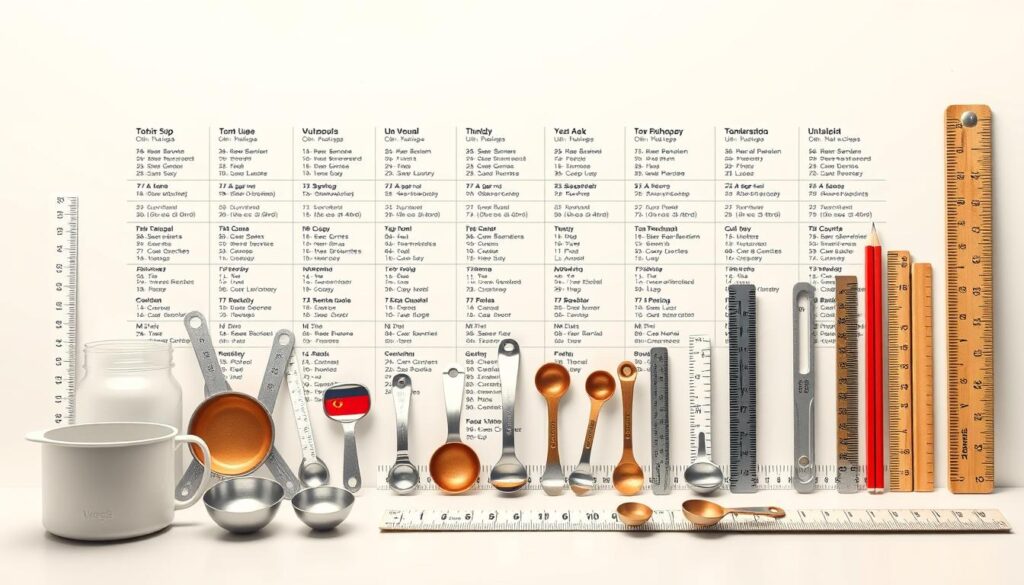
Practical Tips for Quick Kitchen Conversions
With a few simple techniques, you can become proficient in kitchen conversions. Mastering these conversions can save time and reduce stress while cooking. Here are some practical tips to help you achieve this.
Mental Math Shortcuts for Busy Cooks
One of the most useful skills for a cook is being able to perform mental math shortcuts. For instance, knowing that 1 cup is equal to 16 tablespoons can help you quickly convert recipe measurements. By memorizing a few key conversion factors, you can easily scale recipes up or down. This skill is particularly useful when you’re in the middle of cooking and realize you need to adjust the ingredient quantities.
Another mental math trick is to understand the relationship between common kitchen measurements. For example, knowing that 1 tablespoon is equal to 3 teaspoons can help you quickly convert between these units. By applying these simple conversion factors, you can make adjustments to your recipes without needing to consult a conversion chart.
Handy Conversion Charts to Keep in Your Kitchen
While mental math shortcuts are useful, having a conversion chart handy can be a lifesaver in the kitchen. A conversion chart can provide a quick reference for common kitchen conversions, such as tablespoons to cups or ounces to grams. You can find conversion charts online or create your own based on the measurements you use most frequently.
By keeping a conversion chart in your kitchen, you can quickly look up the conversions you need, saving time and reducing the risk of measurement errors. This is especially useful when you’re working with a new recipe or ingredient that you’re not familiar with.
Mobile Apps and Digital Tools for Kitchen Conversions
In today’s digital age, there are many mobile apps and digital tools available that can help with kitchen conversions. These apps can provide a quick and easy way to convert between different units of measurement, and some even offer additional features such as recipe suggestions and meal planning.
Some popular cooking apps include those that allow you to input a recipe and automatically convert the ingredients to the desired units. Others provide a database of common ingredients and their corresponding measurements, making it easy to look up conversions on the fly.
Teaching Children About Measurements Through Cooking
Cooking with children can be a great way to teach them about measurements and conversions. By involving them in the cooking process, you can help them develop important math skills and an understanding of how different measurements relate to each other.
One way to teach children about measurements is to use real-world examples, such as measuring out ingredients for a recipe. You can also use cooking as an opportunity to practice converting between different units of measurement, such as tablespoons to cups or ounces to grams.
| Measurement | Equivalent |
|---|---|
| 1 Cup | 16 Tablespoons |
| 1 Tablespoon | 3 Teaspoons |
Conclusion: Mastering Tablespoon to Cup Conversions
Mastering conversions between tablespoons and cups is a crucial skill for any cook or baker. By understanding the simple conversion formula and applying it in various cooking scenarios, you can ensure that your recipes turn out as expected. Whether you’re a novice cook or an experienced chef, being able to convert between different measurement units with ease can make a significant difference in the quality of your dishes.
With the cooking tips and baking tips provided in this article, you can confidently tackle any recipe that requires tablespoon to cup conversions. From baking applications like cookies and cakes to cooking applications like sauces and marinades, having a solid grasp of measurement conversions is essential. By applying the knowledge gained from this article, you’ll be well on your way to mastering conversions and achieving cooking success.
As you continue to cook and bake, you’ll find that mastering conversions becomes second nature, allowing you to focus on the creative aspects of cooking. With practice and patience, you’ll become proficient in converting between different measurement units, making you a more confident and skilled cook.
FAQ
How many tablespoons are in 1/4 cup?
There are 4 tablespoons in 1/4 cup.
What is the standard conversion formula between tablespoons and cups?
The standard conversion formula is 1 cup = 16 tablespoons. So, to convert tablespoons to cups, you can divide the number of tablespoons by 16.
How do I measure dry ingredients like flour and sugar accurately?
To measure dry ingredients accurately, use a dry measuring cup and level off the ingredients with a straight edge or knife.
Can I use a liquid measuring cup to measure dry ingredients?
While it’s technically possible, it’s not recommended as it can lead to inaccurate measurements. Dry ingredients should be measured using a dry measuring cup to ensure accuracy.
What is the difference between US customary measurements and the metric system?
The US customary system uses units like cups, tablespoons, and teaspoons, while the metric system uses units like milliliters, liters, and grams.
How do I convert a recipe from the US customary system to the metric system?
To convert a recipe, you can use online conversion tools or charts that provide the equivalent metric measurements for US customary units.
What are some common measurement mistakes to avoid in cooking?
Common mistakes include overfilling measuring cups, not leveling off dry ingredients, and using the wrong measuring tools.
Can I use a digital kitchen scale to measure ingredients?
Yes, digital kitchen scales are very accurate and can be used to measure both dry and liquid ingredients.
How can I teach children about measurements through cooking?
You can involve children in the cooking process, explaining the importance of accurate measurements and letting them help with measuring ingredients.
Are there any mobile apps that can help with kitchen conversions?
Yes, there are many mobile apps available that provide conversion charts and calculators for kitchen measurements.
